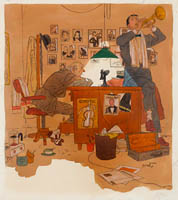Oscar Cahén
In 2011 I was invited to curate with Roger Reed of Illustration House the first exhibition of Oscar Cahén's illustrations since his death in 1956 . I became Scholar in Residence for the Cahén Archives 2013-2016, conducting research that culminated in a book and essays.
Curatorial Statement
Oscar Cahén: Canada's Groundbreaking Illustrator
Jaleen Grove
The primary purpose of the first exhibition of Oscar Cahén’s original illustration art held since his lifetime (1916-1956) is to identify and establish the artist’s place in Canadian commercial graphic art history in four ways: to introduce him to Canadians, to Americans, and to the illustration community; to survey the breadth and depth of the work; to analyze it formally and iconographically with reference to his abstract works; and to address the omission of illustration in art history.
Oscar, as he signed his commercial work, was a household name for Canadians and was most influential among fellow illustrators; many missed him sorely following the car crash that ended his life at 40. This long overdue exhibition therefore has a eulogizing role for Cahén’s relevance as a successful one-time Jewish prisoner of war. It also honours his memory on behalf of his son Michael, who lost his father as a boy and who has kept the collection from which the exhibition draws intact as a trove of not just personal but national cultural memory ever since.
Oscar Cahén needs to be reintroduced to Canadians as an illustrator because he was routinely assigned stories with multi-cultural everyday life themes: in his work, Canada is far more diverse than fine art of the era reveals. Cahén shares a similar life story with a Jewish diaspora in the United States also working in illustration and abstraction (e.g. Shahn, de Kooning, Feininger). Cahén despised repeating himself, so the formal attributes of his works shape-shift constantly, making him an early exponent of the late 1950s turn to “authorial illustration.” His work is appealing to current audiences because it anticipates that of contemporary graphic novels. Accordingly, the emphasis of this project is on an avant-garde impulse for diversity and originality.
38 original works (mainly 1947-1956), and printed samples (1942-1956) are presented along with Cahén’s business cards and personal items. Together, these document Canadian visual culture during wartime and after, in propaganda, in advertising, and in Toronto and Montreal periodicals, as well as national magazines. Because Cahén enjoyed two modes of artistic expression—illustrating and painting—the catalog essay “Bringing Things Into the Light” addresses how the illustration relates to his fine art practice. The thesis is that although Cahén conceived of painting and illustrating as different modes of production, they informed one another equally. Similar techniques and iconography occur in both, dated to the same year. Sometimes seemingly non-objective marks and shapes in paintings are discovered as symbols with specific meanings in illustrations.
Illustration has been excluded from galleries due to its commercial function. Recent scholarship, however, has shown that in a capitalist society no cultural production is isolated from commercial forces. Illustration is undergoing a reassessment just as photography, graphic design and comics have in previous years. Illustration presents a means of understanding culture in ways much contemporaneous fine art—intentionally made to be aloof—cannot. Because it is fundamentally designed to be an art of communication, illustration encourages dialogue on what it depicts. Exhibiting it as art invites further discussion on art’s purpose and value as well.

